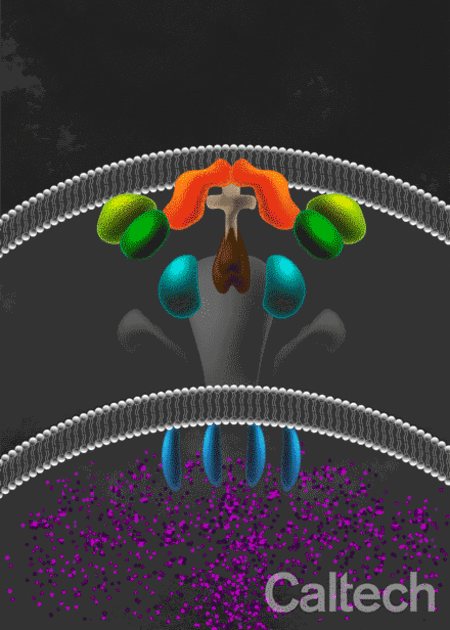3-D image of bacterial machine that injects toxins into cells and spreads antibiotic resistance

Experts predict that by 2050, antibiotic-resistant bacteria will cause as many deaths as cancer. Now, for the first time, Caltech scientists have created a 3-D image of a molecular structure that many different bacteria use to pump toxins into human cells and spread antibiotic-resistance genes to other bacteria. Understanding the architecture of this structure is a first step toward combating its effects.
The study was conducted in the laboratory of Grant Jensen, professor of biophysics and biology and Howard Hughes Medical Institute Investigator. A paper describing the work first appeared online in the March 23 issue of EMBO Reports.
The researchers looked specifically at Legionella, the bacteria that causes Legionnaires' disease, a severe and often lethal form of pneumonia. When Legionella invades a human cell, it wraps itself in a protective vesicle and opens the molecular structure, known as a type IV secretion system. The molecular "machine" sits in the cell membrane of the bacterium and proceeds to shoot tens of thousands of toxic molecules—hundreds of different types—into the human cell, hijacking cellular pathways and overwhelming the cell's defenses.
Some type IV secretion systems are thought to be instrumental in spreading antibiotic-resistance genes throughout the bacterial population.
"Understanding the structure of the type IV system is crucial to developing new antibiotics to disable it," says first author and postdoctoral scholar Debnath Ghosal. "While this study focuses only on the secretion system of Legionella, a very similar machine is used by many bacteria—such as the pathogens that cause stomach cancer, Q fever, and whooping cough."
To image the structure—which, at 40 nanometers in diameter, is about 1,000 times too small to be seen by the human eye—the researchers employed a technique called electron cryotomography. In this method, bacteria are frozen alive and then rotated under a powerful electron microscope to create a series of 2-D images that can be digitally reconstructed into a 3-D picture. This was the first-ever image of a type IV machine within a bacterium.
The imaging revealed that the structure is shaped into concentric arches, like the symbol for Wi-Fi. Understanding the structure should eventually aid efforts to design drugs that can block the machine. Developing a drug that would disable even one core protein component of the secretion system, Ghosal says, would enable human cells to fight back against the bacterial infection.
"Most current antibiotics focus on destroying the cellular envelope that encompasses a bacterial cell, preventing it from replicating," says Jensen. "Developing new antibiotics that target different aspects of the bacterial cell, such as the type IV secretion system, would enable us to block infections in additional ways."
The paper is titled "In situ structure of the Legionella Dot/Icm type IV secretion system by electron cryotomography." In addition to Ghosal and Jensen, coauthors are Caltech research scientist Yi Wei Chang, Kwang Cheol Jeong of the Washington University School of Medicine and the University of Florida, and Joseph Vogel of the Washington University School of Medicine. Funding was provided by the National Institutes of Health and the National Institute of Allergy and Infectious Diseases.
Journal information: EMBO Reports
Provided by California Institute of Technology




















